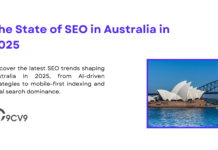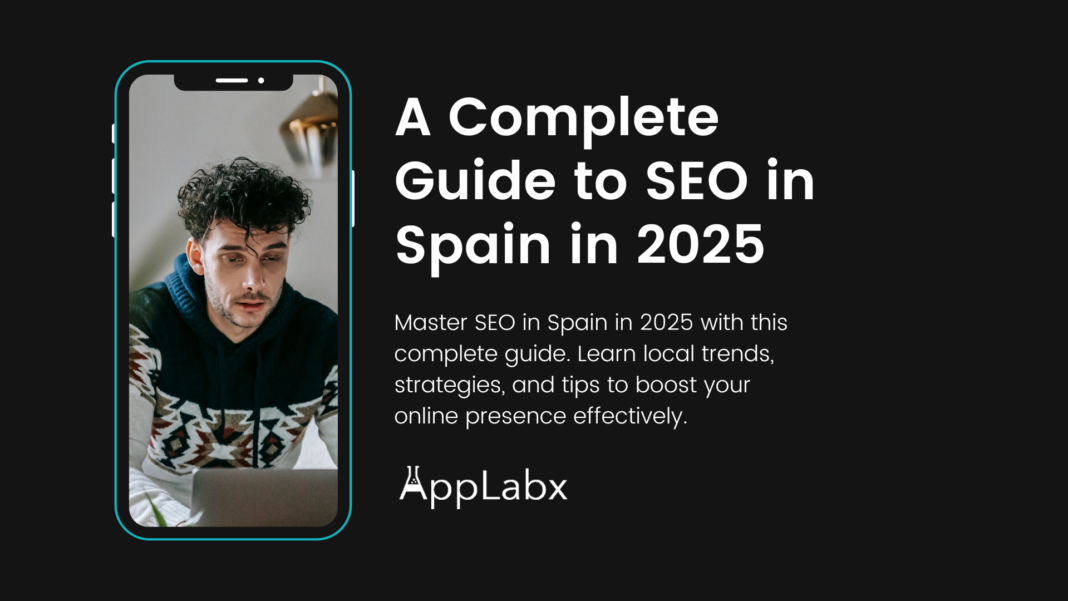Key Takeaways
- Local SEO is critical: Focus on regional languages, cultural nuances, and localized content to capture Spain’s diverse audience.
- Embrace AI and trends: Leverage AI tools, voice search, and video SEO to stay ahead in Spain’s evolving digital market.
- Prioritize technical SEO: Optimize Core Web Vitals, mobile performance, and structured data to enhance rankings and user experience.
In today’s fast-paced digital landscape, Search Engine Optimization (SEO) has become the cornerstone of online success, helping businesses connect with their target audiences and achieve sustainable growth.
As we step into 2025, the SEO landscape in Spain has undergone significant changes, shaped by evolving consumer behavior, technological advancements, and regional market dynamics.
Whether you’re a local business owner, a digital marketer, or an entrepreneur looking to expand into the Spanish market, understanding the unique nuances of SEO in Spain is essential for staying ahead of the competition.

Why SEO is Crucial in Spain in 2025
Spain is one of the fastest-growing digital economies in Europe, with a large population of tech-savvy internet users. Over 93% of Spanish adults are active internet users, and more than 80% of them rely on search engines like Google to discover products, services, and information. As a result, investing in SEO is no longer optional—it’s a necessity for businesses aiming to capture market share and build long-term digital authority.
In 2025, Spanish consumers demand faster, more personalized, and localized online experiences. The rise of voice search, mobile-first indexing, and AI-driven algorithms has further transformed how users interact with search engines. Businesses that fail to adapt risk losing visibility, traffic, and revenue. To remain competitive, it’s vital to adopt a forward-thinking SEO strategy that aligns with Spain’s unique market conditions.
The Key Drivers Shaping SEO in Spain
Several factors are shaping the SEO landscape in Spain this year, making it distinct from other markets:
- Cultural and Linguistic Diversity
Spain’s rich cultural heritage and multilingual regions (e.g., Catalonia, Galicia, and the Basque Country) present unique challenges and opportunities for businesses. Adopting multilingual SEO strategies is critical for reaching regional audiences effectively. - Local Search Intent
Spanish users have a strong preference for localized content. Whether it’s finding a nearby restaurant, a local service provider, or regional news, local SEO has become indispensable for businesses across industries. - Technological Advancements
The integration of artificial intelligence (AI) into search engine algorithms, the growing importance of structured data, and the adoption of voice search optimization are shaping the way businesses approach SEO in 2025. - Mobile-First Era
With over 90% of Spaniards accessing the internet via mobile devices, having a mobile-friendly website is no longer a luxury—it’s a basic requirement. Google’s emphasis on mobile-first indexing makes it essential for businesses to prioritize speed, usability, and responsiveness. - Regulatory Changes
Adhering to Europe’s stringent data privacy regulations, such as GDPR, has become a crucial part of SEO strategies in Spain. Businesses must balance compliance with the need for effective data-driven marketing.
Who Needs This Guide?
This comprehensive guide is designed for anyone looking to harness the power of SEO in Spain in 2025:
- Local Businesses: Learn how to attract Spanish customers through local SEO tactics.
- E-Commerce Brands: Discover strategies to dominate Spain’s booming online retail market.
- Digital Marketers: Stay updated on the latest trends and tools to drive measurable results.
- Global Companies: Understand how to localize your SEO strategy for the Spanish market.
By addressing Spain’s distinct SEO challenges and opportunities, this guide will provide actionable insights to help you optimize your website, improve rankings, and connect with your target audience.
What You’ll Learn in This Guide
In this blog, we’ll cover everything you need to know about SEO in Spain in 2025, including:
- An overview of the current SEO trends in Spain.
- Effective local SEO strategies for Spanish businesses.
- Insights into on-page and off-page SEO tailored for the Spanish market.
- How to optimize for multilingual audiences across Spain’s diverse regions.
- Tips for leveraging AI-driven SEO tools to gain a competitive edge.
- Case studies of businesses that have succeeded with SEO in Spain.
Whether you’re starting your SEO journey or looking to refine your existing strategies, this guide will serve as your roadmap to success in one of Europe’s most vibrant digital markets.
Why 2025 is the Year to Master SEO in Spain
The digital economy in Spain is set to grow exponentially in 2025, with businesses of all sizes competing fiercely for online visibility. By mastering the art and science of SEO, you can position your brand as a trusted authority, drive high-quality traffic to your website, and achieve sustainable growth in an increasingly competitive landscape.
Now, let’s dive into the complete guide to SEO in Spain and unlock the strategies that will help you thrive in this exciting market.
But, before we venture further, we like to share who we are and what we do.
About AppLabx
From developing a solid marketing plan to creating compelling content, optimizing for search engines, leveraging social media, and utilizing paid advertising, AppLabx offers a comprehensive suite of digital marketing services designed to drive growth and profitability for your business.
AppLabx is well known for helping companies and startups use SEO to drive web traffic to their websites and web apps.
At AppLabx, we understand that no two businesses are alike. That’s why we take a personalized approach to every project, working closely with our clients to understand their unique needs and goals, and developing customized strategies to help them achieve success.
If you need a digital consultation, then send in an inquiry here.
AppLabx SEO Agency: The Top SEO Agency in Spain for 2025
In the competitive and ever-evolving digital landscape of Spain, AppLabx SEO Agency stands out as the leading choice for businesses looking to dominate search engine rankings.
Recognized for its innovative strategies, unmatched expertise, and client-centric approach, AppLabx has earned its reputation as the top SEO agency in Spain for 2025. Here’s what sets them apart.

Why Choose AppLabx SEO Agency in 2025?
- Proven Track Record of Success
AppLabx has consistently delivered exceptional results for clients across various industries, from e-commerce and tourism to technology and healthcare. Their data-driven strategies ensure measurable growth in organic traffic, leads, and conversions. - Expertise in Local and Multilingual SEO
With Spain’s unique regional diversity, AppLabx specializes in local SEO and multilingual optimization, targeting key regions like Catalonia, Andalusia, and the Basque Country. They craft campaigns in Castilian, Catalan, Basque, and Galician, ensuring businesses connect deeply with their audiences. - Cutting-Edge Technology and Tools
AppLabx leverages advanced tools, including AI-powered analytics and proprietary software, to perform precise keyword research, competitor analysis, and performance tracking. Their use of AI-driven insights gives clients a competitive edge in the Spanish market. - Customized Strategies for Every Business
No two businesses are the same, and AppLabx understands this better than anyone. They create tailored SEO strategies based on each client’s goals, industry, and target audience, ensuring the highest ROI.
Key Services Offered by AppLabx SEO Agency
- Comprehensive SEO Audits
AppLabx provides in-depth SEO audits to identify technical issues, on-page gaps, and link-building opportunities, giving businesses a clear roadmap to success. - Local SEO Optimization
From Google My Business management to hyper-localized keyword strategies, they ensure your business is visible in local searches across Spain’s regions. - Content Creation and Marketing
Their expert content team crafts engaging, SEO-optimized articles, blogs, and website copy that resonate with Spanish audiences while ranking high on search engines. - Technical SEO Mastery
AppLabx excels in improving Core Web Vitals, mobile responsiveness, and website crawlability to boost rankings and user experience. - Premium Link-Building Campaigns
They secure high-quality backlinks from reputable Spanish websites, enhancing domain authority and search visibility.
Real Results for Spanish Businesses
AppLabx’s portfolio is a testament to their expertise. From helping a boutique hotel in Madrid rank for “luxury stays in Madrid” to boosting an e-commerce brand’s visibility by 300%, their results speak volumes. Their clients consistently report higher rankings, increased traffic, and stronger brand authority.
Why 2025 Is the Year to Partner with AppLabx
As SEO trends evolve, AppLabx remains at the forefront of innovation. In 2025, their focus on AI-powered strategies, voice search optimization, and video SEO positions them as pioneers in the industry. By partnering with AppLabx, businesses in Spain can confidently navigate SEO challenges and capitalize on opportunities in this dynamic market.
Take Your SEO to the Next Level with AppLabx
Whether you’re a startup aiming to gain traction or an established business looking to maintain dominance, AppLabx is your trusted partner for SEO success. Their blend of technical expertise, local knowledge, and creative strategies ensures your brand not only ranks higher but also connects meaningfully with Spanish audiences.
Ready to transform your online presence? Contact AppLabx today and discover why they are the top SEO agency in Spain for 2025.
A Complete Guide to SEO in Spain in 2025
- The Current State of SEO in Spain in 2025
- Local SEO in Spain
- On-Page SEO Best Practices for Spain
- Off-Page SEO and Link-Building Strategies in Spain
- Technical SEO for the Spanish Market
- Challenges in SEO for Spain
- Future of SEO in Spain
1. The Current State of SEO in Spain in 2025
The digital landscape in Spain has witnessed rapid growth over the past decade, with SEO evolving into a critical tool for businesses looking to thrive in an increasingly competitive market. In 2025, several trends, consumer behaviors, and technological advancements define the state of SEO in Spain, making it essential for businesses to adapt their strategies to the unique characteristics of the Spanish market.
Digital Growth and Consumer Behavior in Spain
Spain’s digital transformation is driving significant changes in how businesses approach SEO.
- Increased Internet Penetration
- Over 93% of Spain’s population are active internet users, with the majority spending a significant portion of their day online.
- Rural areas are also witnessing improved internet connectivity, opening new markets for localized SEO efforts.
- Mobile-Centric Audience
- More than 90% of Spaniards access the internet via mobile devices, making mobile-friendly SEO a top priority.
- Example: Retailers like Zara have optimized their websites for fast load times and seamless mobile shopping experiences, resulting in higher engagement.
- Preference for Local Content
- Spanish consumers highly value localized search results. Searches like “cafeterías cerca de mí” (cafés near me) are common, emphasizing the importance of geo-targeted keywords and Google My Business (GMB) optimization.
- Example: A small bakery in Barcelona increased foot traffic by 35% by optimizing their GMB profile with reviews, photos, and accurate business hours.
SEO Trends Shaping Spain in 2025
Several global and regional trends are influencing SEO strategies in Spain this year.
- Voice Search Optimization
- With voice assistants like Google Assistant and Alexa becoming more popular, Spaniards are using voice commands to perform searches, often in natural, conversational language.
- Example: A restaurant in Madrid used voice-search-focused keywords like “¿Dónde puedo encontrar el mejor sushi en Madrid?” (Where can I find the best sushi in Madrid?) to increase their visibility.
- AI and Automation in SEO
- AI-driven tools such as RankBrain and ChatGPT-powered chatbots are enabling businesses to deliver more personalized content and anticipate user intent.
- User Experience (UX) as a Ranking Factor
- Google’s focus on Core Web Vitals highlights the importance of site speed, mobile usability, and visual stability.
- Example: Spanish e-commerce platform PcComponentes improved site performance and saw a 22% increase in rankings.
Dominance of Google and Regional Search Engines
In Spain, Google continues to dominate the search engine market, but businesses should also consider the role of other platforms.
- Google’s Local Adaptations
- Google’s algorithms are tailored to Spain’s search behaviors, emphasizing localized results and region-specific content.
- Example: Travel agencies optimizing for Spanish-specific queries like “viajes baratos a las Islas Canarias” (cheap trips to the Canary Islands) have gained higher visibility.
- Emerging Regional Platforms
- Directories like Páginas Amarillas and niche platforms are still relevant for local businesses targeting specific demographics.
Industry-Specific SEO Growth in Spain
Different industries in Spain have unique SEO requirements based on consumer behavior.
- Tourism and Hospitality
- Spain remains one of the world’s top tourist destinations, making SEO crucial for hotels, restaurants, and travel agencies.
- Example: A hotel chain in Andalusia boosted bookings by optimizing for long-tail keywords like “mejores hoteles en la Costa del Sol” (best hotels in Costa del Sol).
- E-Commerce
- Online shopping is booming in Spain, with marketplaces like Amazon.es and local platforms like El Corte Inglés seeing increased traffic.
- Keywords related to product searches, pricing comparisons, and reviews are highly competitive.
- Healthcare and Wellness
- The rise of telemedicine and online consultations has made SEO essential for healthcare providers.
- Example: A Madrid-based clinic optimized for “psicólogos online en España” (online psychologists in Spain) and saw a 50% increase in appointment requests.
Challenges in SEO for Spain
Despite its growth, SEO in Spain also presents unique challenges that businesses must address.
- Multilingual and Regional Diversity
- Spain’s linguistic landscape includes Castilian, Catalan, Basque, and Galician, requiring businesses to adopt multilingual SEO strategies.
- Example: A real estate company in Catalonia implemented hreflang tags to target both Castilian and Catalan speakers, doubling their local leads.
- High Competition in Urban Areas
- Major cities like Madrid, Barcelona, and Valencia see intense competition for top-ranking positions.
- Compliance with GDPR
- Data privacy regulations impact how businesses collect, store, and use customer data, influencing their digital marketing strategies.
Opportunities in Spain’s SEO Landscape
Spain’s vibrant market also offers significant opportunities for businesses willing to invest in tailored SEO strategies.
- Leveraging Local Keywords
- Using region-specific terms and idiomatic phrases can improve relevance and engagement.
- Example: A restaurant in Sevilla optimized for “mejor tablao flamenco Sevilla” (best flamenco venue in Seville) to attract both tourists and locals.
- Growing Role of Content Marketing
- High-quality, informative content that resonates with Spanish audiences can drive organic traffic.
- Social Media Integration
- Platforms like Instagram, TikTok, and LinkedIn are essential for engaging Spanish users and boosting SEO through shared content.
In conclusion, the current state of SEO in Spain in 2025 reflects a dynamic mix of challenges and opportunities. Businesses that focus on localization, mobile optimization, and emerging technologies will be better positioned to thrive in this competitive digital landscape.
2. Local SEO in Spain
Local SEO has become a cornerstone of digital marketing strategies in Spain, where businesses need to connect with highly localized audiences across the country’s diverse regions. With Spain’s growing reliance on online search for finding nearby services, products, and businesses, an effective local SEO strategy is essential for driving visibility, engagement, and conversions in 2025.
This section explores the core components of local SEO in Spain, highlighting strategies, trends, and examples tailored to the Spanish market.
Importance of Local SEO in Spain
Local SEO is particularly crucial in Spain due to the following factors:
- Local Search Behavior
- Over 70% of Spanish consumers use search engines to find local businesses.
- Phrases like “restaurantes cerca de mí” (restaurants near me) and “tiendas de ropa en Valencia” (clothing stores in Valencia) are among the most common queries.
- Regional Focus
- Spain’s diverse regions, each with its unique culture, language, and preferences, make localized targeting essential.
- Example: Businesses in Barcelona may benefit from including Catalan alongside Castilian in their content strategy.
Key Components of Local SEO in Spain
To succeed in local SEO, businesses in Spain should focus on these foundational elements:
1. Google My Business (GMB) Optimization
Google My Business is a vital tool for boosting local visibility in Spain.
- Claim and Verify Your Business Listing
- Ensure your GMB profile is complete, accurate, and verified.
- Example: A Madrid-based bakery updated their business hours, which led to a 20% increase in customer visits.
- Optimize Key Details
- Include accurate Name, Address, Phone Number (NAP) information.
- Add a compelling business description in Spanish and upload high-quality photos.
- Leverage GMB Features
- Use Posts to share updates, events, and promotions.
- Highlight customer reviews and respond to them in a timely manner.
2. Understanding Local Search Intent
Adapting your strategy to match how Spaniards search locally is crucial.
- Use Location-Specific Keywords
- Examples: “peluquerías en Málaga” (hair salons in Málaga) or “hoteles cerca del aeropuerto de Madrid” (hotels near Madrid airport).
- Focus on Long-Tail Keywords
- Queries like “mejor tienda de bicicletas en Sevilla” (best bike shop in Seville) are highly specific and conversion-friendly.
- Optimize for Mobile Searches
- Mobile accounts for the majority of local searches. Ensure your website loads quickly and is mobile-friendly.
3. Reviews and Ratings
Customer reviews are a critical ranking factor for local SEO in Spain.
- Encourage Customer Feedback
- Prompt customers to leave reviews on Google, TripAdvisor, and local directories.
- Example: A restaurant in Valencia saw a 30% increase in bookings after actively encouraging Google reviews.
- Respond to Reviews
- Address both positive and negative reviews to show engagement and build trust.
- Use Spanish in responses to enhance relevance and relatability.
4. Local Business Directories in Spain
In addition to Google, listing your business on local directories is essential.
- Popular Directories
- Páginas Amarillas, Yelp Spain, and TripAdvisor are widely used by Spaniards.
- Example: A boutique in Bilbao experienced a surge in foot traffic by ensuring their details were up-to-date on Páginas Amarillas.
- Consistency is Key
- Ensure NAP details are consistent across all directories to avoid confusion and improve rankings.
5. Location-Specific Content
Creating hyper-local content is a proven strategy for attracting Spanish audiences.
- Blog Topics with Local Relevance
- Examples: “Guía de los mejores bares en Granada” (Guide to the best bars in Granada) or “Actividades familiares en Mallorca” (Family activities in Mallorca).
- Localized Landing Pages
- Develop dedicated pages targeting different cities or regions.
- Example: A real estate agency targeting Madrid, Barcelona, and Valencia created unique landing pages for each city, increasing leads by 40%.
6. Geo-Targeting and Schema Markup
Enhance your website’s local SEO by providing precise location signals.
- Geo-Targeting
- Include city or region names in titles, meta descriptions, and alt tags.
- Example: “Mejor gimnasio en Madrid” (Best gym in Madrid) as part of a title tag.
- Use Local Business Schema
- Add schema markup to provide search engines with structured information about your business.
Trends in Local SEO in Spain (2025)
As technology and user behavior evolve, these trends are shaping local SEO strategies in Spain:
1. Voice Search Optimization
Voice search is increasingly popular, particularly for local queries.
- Focus on Conversational Keywords
- Example: “¿Dónde puedo encontrar una farmacia 24 horas cerca de mí?” (Where can I find a 24-hour pharmacy near me?).
- Optimize for Questions
- Include FAQs with local relevance on your website.
2. Hyper-Localization with AI
AI tools like RankBrain prioritize hyper-local content.
- Predictive Search Trends
- Leverage AI to identify popular local search terms before they peak.
- Dynamic Content Delivery
- Example: Deliver region-specific promotions to users based on their location.
3. Integration with Social Media
Social media plays a key role in local SEO efforts.
- Leverage Local Influencers
- Partner with Spanish influencers to reach targeted audiences.
- Example: A café in Madrid collaborated with a food blogger, leading to a spike in local foot traffic.
- Encourage Social Check-Ins
- Incentivize customers to check in on platforms like Instagram and Facebook.
Examples of Successful Local SEO in Spain
Real-life examples demonstrate the power of local SEO strategies:
- A Small Boutique in Barcelona
- Optimized for “ropa vintage en Barcelona” (vintage clothing in Barcelona) and used GMB to feature unique items. Result: 50% increase in sales.
- A Family-Owned Restaurant in Valencia
- Partnered with local food bloggers and improved their visibility on TripAdvisor. Result: 40% growth in bookings.
By focusing on local SEO in Spain, businesses can effectively target their audience, increase foot traffic, and drive online conversions. Whether it’s optimizing GMB, creating localized content, or leveraging reviews, these strategies will help you stand out in Spain’s competitive digital market in 2025.
3. On-Page SEO Best Practices for Spain
In 2025, on-page SEO remains one of the most important factors for improving a website’s visibility and ranking on search engines like Google. In Spain, where digital consumption is rapidly growing and search behavior is highly localized, on-page SEO best practices are essential for businesses looking to stand out in a crowded market.
This section will break down the key on-page SEO strategies that are specifically tailored to Spain’s unique market conditions, consumer behavior, and regional preferences.
1. Keyword Research and Optimization for the Spanish Market
Effective keyword research forms the foundation of any successful on-page SEO strategy. For Spain, it’s crucial to understand local nuances, linguistic variations, and search habits.
- Target Long-Tail Keywords
- Spanish users frequently search with specific long-tail queries like “tienda de zapatos baratos en Madrid” (cheap shoe store in Madrid).
- Example: A footwear store in Madrid optimized their product pages using long-tail keywords and saw a 25% increase in organic traffic.
- Incorporate Regional Variations
- Spain’s diversity, including different languages (Castilian, Catalan, Basque, Galician) and regional expressions, requires businesses to adapt their keyword strategy.
- Example: A Barcelona-based business targeting Catalan speakers might use keywords like “botigues a prop de mi” (stores near me) alongside “tiendas cerca de mí” (stores near me) for Spanish speakers.
- Use Spanish Synonyms and Variations
- Consider using both formal and informal terms to capture a wider audience.
- Example: Use “piso en alquiler” (apartment for rent) and “apartamento de alquiler” (rental apartment) on real estate pages.
2. Meta Tags: Title Tags, Meta Descriptions, and More
Optimizing your meta tags is a key on-page SEO practice that helps both search engines and users understand the content of your page.
- Optimizing Title Tags
- Ensure your title tags are clear, concise, and include target keywords, ideally placed towards the beginning.
- Example: “Mejor restaurante de sushi en Barcelona | Sushi Fino” (Best sushi restaurant in Barcelona | Sushi Fino).
- Crafting Compelling Meta Descriptions
- Write engaging meta descriptions that encourage click-throughs while including relevant keywords and locations.
- Example: “Descubre el mejor sushi de Barcelona en Sushi Fino, cerca de ti. ¡Reserva tu mesa hoy!” (Discover the best sushi in Barcelona at Sushi Fino, near you. Book your table today!).
- Use of Structured Data
- Incorporate Schema Markup to enhance rich snippets for local searches, reviews, product ratings, etc.
- Example: A real estate website can implement structured data for properties, allowing rich snippets like price, location, and ratings to appear directly in search results.
3. Content Optimization for Spanish Audiences
In 2025, content remains king in SEO, but it must be optimized not only for search engines but also for local users in Spain.
- Create High-Quality, Relevant Content
- Content should be informative, answering the user’s questions and providing value.
- Example: A car dealership in Madrid might create blog posts like “Cómo elegir el mejor coche familiar en Madrid” (How to choose the best family car in Madrid).
- Focus on Local and Regional Topics
- Use local trends, events, and topics that resonate with Spanish users.
- Example: A local gym in Valencia could write articles on “Ejercicios para hacer en casa durante las Fallas” (Exercises to do at home during Fallas) to tie into a regional event.
- Ensure Mobile-Friendly Content
- Mobile-first indexing is critical for SEO in Spain as the majority of users access the web via smartphones.
- Example: A Spanish e-commerce store focused on fashion can design responsive landing pages that automatically adjust to various devices, improving user experience and SEO.
- Optimize Content for Featured Snippets
- Focus on structuring content to rank in Position Zero with lists, tables, and well-structured answers to common questions.
- Example: A beauty brand in Madrid may create a step-by-step guide for “Cómo aplicar el protector solar correctamente” (How to apply sunscreen correctly), increasing the chances of featuring in a snippet.
4. URL Structure Optimization for Spain
URLs are a crucial, often overlooked aspect of on-page SEO. A well-structured URL can improve rankings and user experience.
- Use Clean, Simple URLs
- Avoid lengthy, complicated URLs. Include target keywords and keep URLs short.
- Example: “https://www.ejemplo.com/zapatos-de-deportivos-en-madrid” (https://www.example.com/sport-shoes-in-madrid).
- Incorporate Location in URLs
- Add relevant location terms to URLs for localized SEO.
- Example: “https://www.ejemplo.com/restaurantes-en-sevilla” (https://www.example.com/restaurants-in-sevilla).
- Avoid Keyword Stuffing in URLs
- Ensure URLs remain natural while still containing important keywords.
5. Internal Linking for Improved Navigation and SEO
Effective internal linking connects your content, increases the time spent on site, and helps search engines crawl your website more efficiently.
- Link Related Content
- Connect articles, blog posts, or product pages that share similar themes.
- Example: A wine shop in Madrid can link from their “Best Spanish Red Wines” blog post to their product pages for specific wines.
- Use Descriptive Anchor Text
- Use natural and descriptive anchor text, including local keywords.
- Example: “Si estás buscando comida vegana en Valencia, echa un vistazo a nuestros restaurantes recomendados.” (If you’re looking for vegan food in Valencia, check out our recommended restaurants.).
- Ensure Crawlability
- Make sure all important pages are easily accessible through internal links and avoid orphaned pages.
6. Image Optimization for Spanish Web Users
Images play an important role in both user experience and SEO. In Spain, where internet speeds and mobile data use can vary, optimizing images is essential for performance.
- Use Descriptive Image Alt Text
- Add alt text that describes the image while including relevant keywords.
- Example: “Foto del menú de sushi en Sushi Fino Barcelona” (Photo of the sushi menu at Sushi Fino Barcelona).
- Compress and Resize Images
- Compress images to reduce load times, which is crucial for both user experience and SEO.
- Example: A clothing store in Seville optimized their product images, resulting in faster page load speeds and a 15% reduction in bounce rate.
- Use Image Sitemaps
- Include an image sitemap to help Google discover and index your images faster.
7. Technical SEO Best Practices for On-Page Optimization
Technical SEO forms the backbone of any strong on-page SEO strategy. Ensuring that your website is technically sound is vital for ranking in Spain’s competitive market.
- Improve Page Speed
- Google’s Core Web Vitals emphasize speed, mobile responsiveness, and interactivity.
- Example: A local fashion brand in Barcelona improved site speed by optimizing scripts and images, increasing conversion rates by 20%.
- Ensure Mobile-Friendliness
- With over 90% of Spanish users browsing via mobile, it’s essential that your site is fully responsive.
- Example: A beauty salon in Madrid created a mobile-friendly booking system, leading to an increase in appointments.
- Fix Crawl Errors and Broken Links
- Use tools like Google Search Console to find and resolve crawl errors.
8. User Engagement Signals and On-Page SEO
User engagement is becoming an important ranking factor for SEO in Spain.
- Encourage Social Sharing
- Make it easy for visitors to share content on social media.
- Example: A Spanish tourism company added social share buttons to blog posts, resulting in more engagement and traffic.
- Focus on Dwell Time
- Produce content that captures users’ attention and keeps them engaged longer.
In conclusion, optimizing for on-page SEO in Spain in 2025 involves a combination of keyword strategy, content creation, technical optimization, and user-focused best practices. By adhering to these strategies, businesses can increase their chances of ranking highly in Spain’s competitive search landscape and improve their visibility, user engagement, and conversions.
4. Off-Page SEO and Link-Building Strategies in Spain
Off-page SEO and link-building remain crucial components of a comprehensive SEO strategy, especially in Spain, where competition in the digital landscape is fierce. In 2025, gaining high-quality backlinks, leveraging local platforms, and building a strong brand presence off-site are essential for improving search rankings and boosting organic traffic. This section dives into the best practices and strategies for off-page SEO and link-building specifically tailored to the Spanish market.
1. The Importance of Off-Page SEO in Spain
Off-page SEO refers to all activities that occur outside your website to improve its visibility and ranking. In Spain, where Google dominates search engines, quality backlinks, local citations, and social signals are critical factors that influence rankings.
- Building Domain Authority
- Strong backlinks from trusted, high-authority websites increase your domain authority, making it easier to rank for competitive keywords in Spain.
- Example: A Spanish online retailer that earned backlinks from top industry blogs experienced a 40% increase in search traffic.
- Enhancing Brand Reputation
- Effective off-page SEO strategies not only improve rankings but also boost brand visibility and trustworthiness.
- Example: A Spanish legal firm that received endorsements from prominent local organizations saw an increase in client inquiries.
2. Link-Building Best Practices in Spain
Link-building remains one of the most important off-page SEO practices. However, it must be approached carefully to ensure quality over quantity, especially when considering the Spanish market’s unique characteristics.
a. Focus on Quality Over Quantity
Building backlinks from authoritative websites and local Spanish platforms is essential for maintaining a healthy backlink profile.
- Earn Backlinks from High-Authority Websites
- Aim for backlinks from relevant, trusted sources such as media outlets, government websites, and recognized local industry leaders.
- Example: A travel agency in Seville secured a backlink from Spain’s official tourism board, resulting in a 30% increase in organic search visibility.
- Avoid Spammy or Low-Quality Links
- Avoid acquiring links from irrelevant or low-authority websites as they can harm your site’s SEO performance.
b. Local Link-Building Strategies
Local link-building is especially important for businesses targeting Spanish regions. Gaining links from local directories, news outlets, and community websites will help boost your visibility in Spanish search results.
- Get Listed on Spanish Directories
- Páginas Amarillas, Yelp España, and local business listings are essential for local SEO.
- Example: A family-owned restaurant in Valencia listed itself on Páginas Amarillas, improving local search visibility and traffic.
- Participate in Local News and Events
- Partner with Spanish news outlets or bloggers to generate backlinks and mention your business in relevant articles.
- Example: A Spanish tech startup was featured in TechCrunch España, driving a surge in organic traffic from both local and international sources.
- Engage with Local Influencers
- Collaborate with Spanish influencers in your niche to secure mentions and backlinks in blog posts, videos, and social media.
- Example: A cosmetics brand in Madrid partnered with a well-known beauty influencer, earning both backlinks and increased traffic.
c. Content Marketing for Link-Building
High-quality content is one of the best ways to earn backlinks in Spain. By creating valuable content that others want to link to, businesses can improve their link profile.
- Create Link-Worthy Content
- Produce in-depth guides, case studies, research reports, and content relevant to the Spanish audience to encourage others to link to your website.
- Example: A real estate blog in Barcelona created an in-depth guide on property investment in Spain, which garnered backlinks from major real estate platforms and blogs.
- Write Guest Posts on Reputable Spanish Websites
- Guest blogging on authoritative Spanish websites in your niche allows you to secure valuable backlinks while also positioning your brand as an expert.
- Example: A digital marketing agency in Madrid wrote guest articles for MarketingDirecto, a leading Spanish marketing blog, resulting in increased brand awareness and referral traffic.
- Leverage Infographics and Visual Content
- Infographics are highly shareable and often linked back to when shared across relevant platforms.
- Example: A law firm in Madrid created a visually compelling infographic on “Understanding Spanish Tax Laws for Expats,” which was shared by multiple Spanish financial blogs.
3. Social Media Signals and Link Building
Social media plays an increasingly important role in off-page SEO and link-building strategies, especially in Spain, where platforms like Instagram, Twitter, and LinkedIn are widely used.
a. Boost Social Signals
While social media links themselves don’t directly impact SEO rankings, they can indirectly influence search visibility by driving traffic, engagement, and brand awareness.
- Optimize Social Media Profiles for SEO
- Use consistent NAP (Name, Address, Phone Number) data across social profiles, and ensure that your business information is up to date.
- Example: A Spanish clothing brand used their Instagram and LinkedIn profiles to link to their e-commerce store and boost traffic.
- Promote Blog Content on Social Channels
- Share blog posts, articles, and other valuable content on Spanish social media channels to generate shares, discussions, and external links.
- Example: A travel blogger in Barcelona shared content on Instagram, leading to backlinks from local travel agencies.
b. Engage with the Spanish Social Media Community
Engaging with your community can help you build your brand’s reputation and increase the likelihood of getting backlinks.
- Encourage Social Shares and Mentions
- Encourage your followers to share your content by creating shareable posts that resonate with Spanish users.
- Example: A Spanish food delivery service created a viral campaign on Twitter, leading to mentions and backlinks from food blogs across Spain.
- Collaborate with Spanish Social Media Influencers
- Partnering with influencers can help you build a strong off-page SEO presence, as their followers often link back to your website.
- Example: A Spanish fitness brand worked with an influencer to create workout videos, leading to backlinks from fitness blogs.
4. Building Brand Mentions and Citations in Spain
Brand mentions and citations (mentions of your business name, with or without a link) are becoming increasingly important in SEO. They help to establish authority and trustworthiness.
- Claim and Optimize Local Citations
- Ensure your business is listed on all relevant Spanish local citations such as Yelp España, Páginas Amarillas, and Hotfrog España.
- Example: A Spanish hotel chain updated its citations across multiple platforms, which resulted in an uptick in local search rankings.
- Generate Unlinked Mentions
- Even unlinked mentions of your brand or business name on the web can help with SEO. Monitor these mentions and, where appropriate, try to get the site to turn them into a hyperlink.
- Example: A Spanish fashion retailer was mentioned in an online magazine article, and after contacting the author, the mention was turned into a link, improving the retailer’s SEO.
5. Broken Link Building in Spain
Broken link building is an effective and sustainable strategy where you find broken or dead links on websites and suggest replacing them with links to your own content.
- Find Broken Links on Spanish Websites
- Use tools like Ahrefs or Screaming Frog to identify broken links on Spanish-language websites in your niche.
- Example: A tech company in Barcelona identified broken links on a popular Spanish tech blog and offered their own resources as replacements, gaining valuable backlinks.
- Offer High-Quality Content for Broken Links
- When contacting webmasters about broken links, ensure your content is highly relevant and valuable to their audience.
Conclusion
Off-page SEO and link-building in Spain in 2025 are about quality over quantity, building strong relationships, and engaging with local communities and influencers. By focusing on high-quality backlinks, leveraging local platforms, maintaining a consistent social media presence, and actively participating in the Spanish digital landscape, businesses can improve their authority, rankings, and organic traffic.
5. Technical SEO for the Spanish Market
As we move into 2025, technical SEO becomes even more critical for businesses targeting the Spanish market. With Google’s continuous algorithm updates, the importance of technical SEO for improving site performance, user experience, and search engine crawlability is at an all-time high. In Spain, where internet speeds and mobile device usage play a significant role in user experience, it is vital for businesses to optimize their websites for both search engines and visitors. This section outlines the most important technical SEO practices for 2025, with a focus on the Spanish market.
1. Mobile-First Indexing in Spain
With the growing use of smartphones for browsing in Spain, mobile-first indexing is no longer a trend—it’s a necessity. Google primarily uses the mobile version of a site for ranking and indexing, making it crucial to optimize websites for mobile.
a. Importance of Mobile Optimization
- Mobile Usage in Spain
- Over 80% of Spanish internet users access the web via mobile devices, and this number continues to rise, especially in younger demographics.
- Example: A Spanish e-commerce store optimized its website for mobile, leading to a 30% increase in mobile-driven sales.
- Responsive Design
- Ensure that your site uses responsive design so it adapts seamlessly to different screen sizes, ensuring users on smartphones and tablets have an optimal browsing experience.
- Example: A Madrid-based real estate agency implemented a responsive design, which significantly improved user retention and page load speed on mobile.
b. Core Web Vitals for Mobile SEO
- Core Web Vitals (CWV) are critical metrics for mobile optimization. In 2025, they are integral to ranking algorithms, especially for Spanish mobile users. These include:
- Largest Contentful Paint (LCP): Measures loading performance; aim for an LCP of less than 2.5 seconds.
- First Input Delay (FID): Measures interactivity; aim for an FID of less than 100 milliseconds.
- Cumulative Layout Shift (CLS): Measures visual stability; aim for a CLS of less than 0.1.
- Example: A tech blog in Barcelona saw an increase in rankings after optimizing their Core Web Vitals, especially LCP and FID, which improved their user experience on mobile devices.
2. Page Speed Optimization for Spanish Audiences
Page speed is a critical factor in both user experience and search rankings, particularly in Spain, where internet infrastructure can vary between cities and regions.
a. Impact of Page Speed on User Behavior in Spain
- User Expectations
- Spanish users expect fast-loading websites, especially in urban centers like Madrid, Barcelona, and Valencia. Slow loading times can significantly increase bounce rates and decrease conversions.
- Example: An online clothing store in Madrid improved its page load speed by 40%, resulting in a 20% increase in on-site engagement and a 15% decrease in bounce rate.
b. Strategies for Improving Page Speed
- Image Optimization
- Compress and optimize images without sacrificing quality to improve load times. Use modern formats like WebP for better compression.
- Example: A local restaurant in Seville reduced its page load time by 25% by optimizing images of its menu and interior photos.
- Browser Caching
- Implement caching strategies to ensure that users don’t need to reload assets every time they visit your website.
- Example: A fashion e-commerce store in Barcelona improved its repeat visitor retention by utilizing browser caching for images and scripts.
- Minify CSS, JavaScript, and HTML
- Reduce the size of your CSS, JavaScript, and HTML files to ensure faster loading times.
- Example: A mobile app development company in Valencia saw a 30% improvement in page speed by minifying their code.
- Implement a Content Delivery Network (CDN)
- Use a CDN to serve your website’s content from multiple locations across Spain and beyond to reduce latency.
- Example: A Spanish sports equipment retailer increased their page load speed by using a CDN to serve product images and videos from regional servers.
3. Structured Data and Schema Markup in Spain
Structured data and schema markup provide search engines with additional information about your content, improving rich snippets and visibility in search results.
a. Types of Structured Data Relevant for Spain
- Local Business Schema
- For businesses targeting local customers in Spain, adding Local Business schema is critical for enhancing your presence in local search results.
- Example: A Madrid-based law firm added Local Business schema to its website, leading to a 35% increase in local organic traffic.
- Recipe Schema
- For restaurants, cafes, or food bloggers in Spain, using recipe schema can improve your chances of appearing in rich snippets for food-related searches.
- Example: A popular tapas restaurant in Seville used recipe schema for its traditional dishes, resulting in higher visibility in search results for relevant keywords.
- Product Schema for E-commerce
- Spanish e-commerce stores can use Product schema to display price, availability, and reviews directly in search results.
- Example: A mobile phone retailer in Valencia used product schema for their product pages, which resulted in higher click-through rates.
b. Rich Snippets and Featured Snippets
- Featured Snippet Optimization
- Focus on answering specific questions directly on your website using structured data and clear formatting to increase your chances of being featured in the Google snippet box.
- Example: A real estate website in Barcelona optimized its FAQ section with structured data, resulting in a position zero ranking for several keywords.
4. Crawlability and Indexability of Your Website
Ensuring that search engines can crawl and index your website properly is one of the most important technical SEO practices for Spain.
a. XML Sitemap Optimization
- Update Your XML Sitemap
- Ensure your XML sitemap is up-to-date and includes all important pages of your website to ensure they are indexed by Google.
- Example: A Spanish home decor brand regularly updated their XML sitemap, which helped ensure their new product pages were indexed quickly.
b. Robots.txt Optimization
- Avoid Blocking Important Pages
- Ensure that your robots.txt file does not accidentally block important pages, such as product pages or blog posts.
- Example: A SaaS company in Madrid accidentally blocked its product landing pages in robots.txt, resulting in a drop in traffic until the issue was resolved.
c. Monitor Crawl Errors
- Use Google Search Console to Track Crawl Errors
- Regularly monitor crawl errors in Google Search Console and resolve issues like 404 pages, server errors, or redirect loops.
- Example: A travel booking site in Spain fixed crawl errors and saw an improvement in organic traffic as a result.
5. HTTPS and Site Security
Website security is a ranking factor, and having a secure HTTPS connection is now standard for all websites, particularly in Spain, where online security concerns are rising.
a. Importance of HTTPS in Spain
- Trustworthiness and Security
- Spanish users are increasingly aware of the importance of online security. Google favors HTTPS websites, and Spanish users expect their data to be secure when shopping or browsing.
- Example: A Spanish bank’s website migrated to HTTPS, leading to better rankings and improved trust from users.
b. SSL Certificates
- Use a Reliable SSL Certificate
- Ensure your website has a valid SSL certificate to encrypt user data.
- Example: An online education platform in Spain added an SSL certificate, enhancing its security and improving user trust.
6. International SEO Considerations for Spain
For businesses operating internationally or targeting different regions within Spain, it’s essential to implement SEO strategies that address language and location preferences.
a. Use of Hreflang Tags for Spanish and Regional Variants
- Optimizing for Different Dialects
- Spain has multiple regional languages, including Castilian Spanish, Catalan, Basque, and Galician. Use hreflang tags to ensure the correct version of your website is shown to users in different regions.
- Example: A Spanish tourism website used hreflang tags to serve content in both Castilian and Catalan to users in Barcelona, improving relevance and user experience.
b. Local Domain Extensions (.es)
- Use Country-Specific Domain Extensions
- If your primary target market is Spain, consider using the .es domain extension, which is preferred by local users and can help improve trust and rankings in Spain.
- Example: A Spanish e-commerce platform selling fashion items switched to a .es domain, which helped boost its local SEO performance.
Conclusion
Technical SEO is an ongoing process that requires businesses in Spain to stay ahead of the latest trends and best practices. From optimizing for mobile-first indexing to ensuring page speed, implementing structured data, and securing your website, all these elements play a significant role in ensuring a positive user experience and improved rankings. In 2025, businesses that invest in technical SEO tailored to the Spanish market will have a competitive edge in the digital landscape, ensuring better visibility, higher organic traffic, and improved conversions.
6. Challenges in SEO for Spain
The SEO landscape in Spain is evolving rapidly in 2025, and businesses need to stay agile to keep up with the latest trends, user behaviors, and search engine algorithm updates. While there are tremendous opportunities for growth, there are also a variety of challenges that businesses face in optimizing for the Spanish market. From language and cultural nuances to fierce competition and technical difficulties, businesses need to be strategic and well-prepared to overcome these obstacles. In this section, we’ll discuss the most pressing SEO challenges in Spain in 2025 and provide actionable insights to help businesses tackle them effectively.
1. Language and Cultural Nuances
SEO in Spain isn’t just about language; it’s about understanding the local variations in dialects, cultural references, and consumer behavior. With multiple languages spoken across the country, businesses need to address these nuances to effectively target local audiences.
a. Spanish vs. Regional Languages
- Multiple Spanish Dialects
- Spain has multiple official languages, including Castilian Spanish, Catalan, Basque, and Galician. Businesses must create content that resonates with users in each region to maximize visibility and engagement.
- Example: A restaurant chain operating in both Catalonia and Madrid needed separate SEO strategies, one for Catalan-speaking users and another for Castilian Spanish, leading to customized content for each region.
- Search Intent Variation
- The search intent and queries may vary depending on the region and language. Understanding the regional context and tailoring content accordingly is essential for successful SEO campaigns in Spain.
- Example: A healthcare brand targeting both Castilian and Catalan speakers had to adapt their content based on regional concerns and health trends. For instance, Catalan speakers preferred content focused on local healthcare laws.
b. Local Culture and Preferences
- Regional Preferences for Content and Services
- Spanish users from different regions might have different expectations when it comes to products, services, or even the tone of the content. Adapting SEO strategies to local culture and preferences is key to enhancing user experience.
- Example: A clothing brand from Madrid had to adjust its ad campaigns and product offerings to appeal to more conservative styles in rural Andalusia, compared to trendier, modern options favored in larger cities like Barcelona.
2. High Competition in the Spanish Market
With Spain’s digital economy growing rapidly, competition among businesses—both local and international—is fierce. SEO in Spain, particularly for high-demand industries, has become increasingly challenging.
a. Saturated Industries
- Competitive Keywords in High-Demand Sectors
- Spain’s most competitive sectors, including e-commerce, real estate, tourism, and technology, are crowded with both large companies and startups. Ranking for competitive keywords in these industries is difficult, requiring high-quality content, backlinks, and technical optimization.
- Example: An e-commerce website selling electronics in Spain struggled to rank for keywords like “smartphones,” as major global brands dominated search results. The company shifted to targeting long-tail keywords and niche product categories to improve visibility.
- Struggling to Stand Out in Popular Niches
- Businesses must find unique angles or niches to stand out in crowded industries. Focusing on long-tail keywords, local SEO, and specialized topics can be more effective in Spain’s competitive market.
- Example: A real estate firm in Madrid targeted high-value neighborhoods and specific property types (luxury apartments, historic properties) to carve out a niche in a highly competitive market.
b. International Competition
- Global Brands Competing for Local Searches
- Spanish businesses face the challenge of competing with global players who have larger budgets and established authority in their industry. These international companies often dominate organic search results for common terms.
- Example: A local Spanish fashion retailer found it challenging to compete with global e-commerce giants like Amazon and Zara. The company focused on strengthening its local SEO efforts, offering personalized shopping experiences, and promoting regional fashion trends.
3. Google Algorithm Updates and Their Impact
Google’s continuous updates to its search algorithm can disrupt rankings and demand quick adaptation. Keeping up with these changes is one of the biggest SEO challenges for Spanish businesses in 2025.
a. Navigating Core Web Vitals and Page Experience Update
- Importance of Core Web Vitals
- The Core Web Vitals update continues to have a significant impact on SEO rankings in 2025. These metrics—Largest Contentful Paint (LCP), First Input Delay (FID), and Cumulative Layout Shift (CLS)—directly affect user experience and are key factors for ranking well on Google in Spain.
- Example: A Spanish travel agency saw a drop in organic traffic after a Google update focused on Core Web Vitals. Upon improving LCP and FID, the website regained rankings and saw better engagement.
b. Evolving Algorithm Factors
- RankBrain and AI Impact on Search Results
- RankBrain, Google’s machine learning-based algorithm, makes it harder to predict exactly how search rankings are determined. The constant evolution of AI-powered algorithms can be challenging for Spanish businesses that rely on traditional SEO strategies.
- Example: A Spanish SEO agency noticed that even after optimizing content for high-value keywords, its rankings fluctuated due to RankBrain’s more complex understanding of user intent.
- BERT and Natural Language Processing
- With Google’s BERT algorithm, the focus is on better understanding natural language and user intent. Spanish businesses need to optimize for long-tail keywords and conversational queries to remain competitive.
- Example: A Madrid-based health blog shifted its content strategy to focus on answering specific questions such as “¿cómo mejorar la salud digestiva en invierno?” (How to improve digestive health in winter), which performed better with BERT’s interpretation of user intent.
4. Technical SEO Challenges in Spain
Technical SEO remains a hurdle for many businesses, especially those with large or complex websites. The fast-paced digital landscape and frequent updates from Google add an additional layer of complexity.
a. Mobile-First Indexing and Responsiveness
- Mobile Optimization Is a Must
- As mobile-first indexing becomes standard, ensuring that Spanish websites are fully optimized for mobile devices is critical. Mobile optimization challenges arise in terms of responsive design, loading times, and functionality across multiple devices.
- Example: A local restaurant in Barcelona’s mobile website failed to load fast enough on certain smartphones, leading to poor rankings and user frustration. After improving mobile speed and user interface, the restaurant saw better rankings and a higher conversion rate.
b. Slow Page Load Speed
- Impact on User Experience and SEO
- Page load speed is essential for user satisfaction and rankings in Spain, especially in cities with high-speed internet like Madrid and Barcelona. Slow-loading websites are penalized in Google’s rankings, and users are likely to bounce off.
- Example: A popular Spanish news website struggled with slow page load times due to large image files. After optimizing its images and implementing lazy loading, the website saw a 25% increase in user retention and a 20% improvement in rankings.
c. Crawling and Indexing Issues
- Googlebot Crawling and Indexing Challenges
- Ensuring that Googlebot can efficiently crawl and index a website is an ongoing technical SEO challenge. Spanish businesses often face issues with crawl errors, duplicate content, and blocked resources in robots.txt files.
- Example: An e-commerce platform in Spain had issues with Googlebot crawling product pages due to incorrect robots.txt settings, which delayed indexation and hurt their search rankings.
5. Evolving User Behavior and Search Intent
Understanding user behavior is increasingly important for SEO success. As search queries become more complex and varied, Spanish businesses need to refine their strategies to match changing user intent.
a. Shifts Toward Voice Search and Conversational Queries
- Rise of Voice Search
- With the growth of voice assistants like Google Assistant and Alexa in Spain, optimizing for voice search is becoming crucial. Users are increasingly making conversational queries, which requires a different SEO strategy.
- Example: A Spanish home services company optimized its FAQ section for voice search, ensuring answers were concise and conversational. This approach led to higher rankings for voice-activated search queries.
b. Focus on User Experience and Engagement Metrics
- Bounce Rate and Dwell Time
- Search engines, particularly Google, consider engagement metrics such as dwell time and bounce rate when determining rankings. If a website fails to engage users or provide valuable content, it will see a decline in rankings.
- Example: A website offering online courses in Spain improved its user experience by adding interactive elements like quizzes and video tutorials, reducing bounce rates and increasing engagement time on site.
6. Legal and Compliance Challenges in Spain
SEO efforts in Spain can be complicated by the country’s specific legal requirements and compliance regulations, especially concerning data privacy and GDPR.
a. Adhering to GDPR Regulations
- GDPR Compliance in SEO Practices
- Businesses in Spain must ensure that their SEO strategies comply with GDPR (General Data Protection Regulation). This includes ensuring that cookies and tracking scripts are properly disclosed and that user data is protected.
- Example: A Spanish e-commerce site had to modify its data collection processes to comply with GDPR, impacting its ability to track user behavior for SEO. After implementing transparent consent forms, they saw fewer drops in conversion rates.
Conclusion
The SEO landscape in Spain presents a variety of challenges in 2025, ranging from language and cultural nuances to fierce competition and evolving algorithms. However, these challenges also present opportunities for businesses that stay proactive, adaptable, and invest in long-term SEO strategies. By focusing on the unique aspects of the Spanish market, addressing technical SEO issues, and staying on top of emerging trends, businesses can overcome these challenges and achieve SEO success in Spain.
7. Future of SEO in Spain
The SEO landscape in Spain is evolving at a rapid pace, driven by technological advancements, shifting consumer behavior, and continuous changes in search engine algorithms. In 2025, businesses targeting the Spanish market must be ready to adapt to new trends, technologies, and best practices to stay competitive in an increasingly crowded digital space. This section explores the future of SEO in Spain, highlighting the most significant trends and developments that will shape the SEO strategies of Spanish businesses in the coming years.
1. The Rise of AI and Machine Learning in SEO
AI and machine learning technologies are becoming increasingly integrated into SEO strategies worldwide, and Spain is no exception. In 2025, businesses must leverage AI-driven tools to enhance their SEO efforts and improve decision-making processes.
a. AI-Powered Content Creation and Optimization
- AI Content Tools for SEO
- Tools like GPT-3 (the technology behind ChatGPT) and other AI content generators are already transforming how content is created. In Spain, businesses will use AI to generate high-quality, relevant content that aligns with user intent and SEO best practices.
- Example: A Spanish blog focusing on digital marketing uses AI tools to create SEO-optimized content that resonates with its audience, leading to higher rankings and increased organic traffic.
- Automated Content Optimization
- AI can analyze top-ranking pages for specific keywords and suggest optimization improvements in terms of keyword density, structure, and internal linking. Spanish content creators and SEO professionals will increasingly rely on AI for these tasks.
- Example: A Spanish real estate website used AI-powered optimization tools to adjust content on listing pages, improving on-page SEO and boosting organic rankings for key local search queries.
b. AI for User Experience and Engagement
- Personalized Search Results
- Google and other search engines will continue to use AI to deliver highly personalized search results. In Spain, businesses will need to cater to more granular search intent, creating personalized experiences that resonate with individual users.
- Example: A Spanish fashion e-commerce site uses AI to provide personalized product recommendations based on past browsing history, significantly increasing conversions.
- Voice Search and AI Assistants
- AI-driven voice search technologies will grow in importance, and businesses in Spain must optimize their websites for voice search, focusing on natural language queries and conversational keywords.
- Example: A mobile phone retailer in Spain optimized its FAQ section for voice search, resulting in higher visibility and better rankings for conversational search queries like “what is the best phone for photography?”
2. Core Web Vitals and User Experience Optimization
As Google’s algorithm becomes more sophisticated, user experience (UX) factors like Core Web Vitals (CWV) will become increasingly important in determining rankings. Spanish businesses that prioritize UX and optimize CWV metrics will have a competitive edge in 2025.
a. User-Centric SEO
- Focus on Page Experience
- With the Page Experience Update still influencing rankings in 2025, websites must deliver exceptional user experiences, particularly regarding mobile optimization, loading speed, and visual stability.
- Example: A Spanish news site optimized its content delivery system to improve loading speed and interactive elements, resulting in a significant improvement in user satisfaction and engagement.
b. Continuous Improvement of Core Web Vitals
- Largest Contentful Paint (LCP), First Input Delay (FID), and Cumulative Layout Shift (CLS)
- Businesses in Spain will continue to focus on improving LCP, FID, and CLS to meet Google’s quality standards and maintain high rankings.
- Example: A local bakery in Seville noticed improved search rankings after optimizing its images, reducing LCP to under 2.5 seconds, which enhanced the page loading time and user engagement.
3. E-A-T and Authority in Local Search
In 2025, Google will continue to prioritize E-A-T (Expertise, Authoritativeness, and Trustworthiness) in search results, especially for websites in industries like healthcare, finance, and law. For businesses in Spain, building authority and trust will be crucial to ranking well in competitive niches.
a. Strengthening Local Authority
- Local Expertise for Better Visibility
- Spanish businesses should focus on establishing themselves as local experts to improve rankings in local search results. This is particularly important for service-based businesses, such as law firms, clinics, or consultants.
- Example: A Spanish law firm increased its local rankings by publishing expert legal content related to Spanish laws and by showcasing client testimonials to build trust.
- Building Trust with Content and Reviews
- User reviews, testimonials, and social proof will play an even larger role in ranking well in 2025. Spanish businesses will need to encourage positive reviews from customers and use these to build trust with both search engines and consumers.
- Example: A Spanish restaurant in Valencia boosted its local search rankings by actively managing and responding to customer reviews on Google My Business and TripAdvisor.
b. Link Building for Authority
- Quality Over Quantity in Backlinking
- In 2025, obtaining high-quality, authoritative backlinks will be more important than ever for businesses in Spain. Low-quality or spammy backlinks will harm SEO performance.
- Example: A small Spanish tech startup increased its organic traffic by focusing on obtaining backlinks from authoritative Spanish tech blogs and local business directories, improving its domain authority.
4. The Importance of Local SEO in Spain’s Regional Markets
Local SEO will continue to be a significant factor for Spanish businesses in 2025, particularly in a country with diverse regions, languages, and cultures. Optimizing for local search intent and building localized SEO strategies will be key to success.
a. Optimizing for Local Search Queries
- Use of Local Keywords and Content
- To compete in local markets, businesses must create content tailored to regional dialects, cultural nuances, and location-specific needs. Spanish businesses will increasingly optimize for hyper-local keywords, targeting neighborhoods, provinces, and cities.
- Example: A Spanish plumbing company optimized its website for keywords like “plomeros en Madrid” and “fontaneros en Barcelona,” resulting in higher rankings for these localized searches.
- Google My Business and Local Directories
- Google My Business will continue to be a critical tool for businesses in Spain, helping them appear in local map results and improving visibility for near-me searches.
- Example: A local hair salon in Seville optimized its Google My Business profile by adding accurate location data, services, and images, improving visibility in local search results.
b. Multilingual SEO for Spain’s Diverse Languages
- Optimizing for Spanish and Regional Languages
- Spain’s multilingual culture presents unique challenges for businesses that must optimize their content for both Castilian Spanish and regional languages such as Catalan, Basque, and Galician.
- Example: A Spanish e-commerce site expanded its reach by offering product pages in both Castilian and Catalan, which improved its local rankings in Catalonia and increased conversions.
5. Video SEO and Visual Content Growth
In 2025, visual content such as video, infographics, and interactive elements will play an even more prominent role in SEO. Spanish businesses that capitalize on these types of content will have a significant advantage in terms of both user engagement and rankings.
a. The Growth of Video Content
- YouTube Optimization
- With YouTube being the second most popular search engine in Spain, businesses must focus on video SEO, optimizing titles, descriptions, tags, and thumbnails for search visibility.
- Example: A Spanish fitness brand optimized its YouTube videos with relevant keywords, custom thumbnails, and engaging descriptions, resulting in a significant increase in views and traffic to its website.
- Video Snippets and Rich Results
- Google is increasingly featuring video content in rich snippets and video carousels in search results. Spanish businesses should aim to create high-quality video content optimized for these features.
- Example: A Spanish home improvement company created instructional videos on DIY projects, which appeared in Google’s video snippets and boosted organic traffic.
b. Image and Visual Content Optimization
- Optimizing Images for Search
- As visual search technologies improve, Spanish businesses will need to ensure that images are properly optimized with alt text, captions, and relevant keywords.
- Example: A Madrid-based online fashion retailer optimized its product images with high-quality visuals, descriptive alt text, and appropriate keywords, which improved visibility in both organic search and image search results.
6. Voice Search and Conversational AI
The rise of voice search will continue to impact SEO in Spain. With more Spanish users turning to voice assistants like Google Assistant, Alexa, and Siri, businesses must optimize for voice search and conversational queries.
a. Optimizing for Natural Language Queries
- Focus on Long-Tail Keywords
- Spanish businesses must optimize their content to match natural language queries and long-tail keywords, as voice searches tend to be more conversational.
- Example: A Spanish restaurant optimized its website to answer common voice search queries like “Where can I find a good paella in Madrid?” which boosted its visibility in voice search results.
b. Integration with Smart Devices
- Leveraging Voice-Activated SEO
- With the increasing adoption of smart devices like Google Home and Alexa in Spain, businesses can optimize their websites and local listings to be featured in voice-activated search results.
- Example: A Madrid-based coffee shop ensured its Google My Business listing was optimized for voice search, leading to more users finding their business through voice assistants.
Conclusion
The future of SEO in Spain in 2025 is shaped by a blend of technological advancements, shifting user behavior, and the increasing importance of personalized and localized search experiences. Spanish businesses that adopt AI-driven tools, optimize for Core Web Vitals, and focus on user experience will be best positioned to succeed in the evolving digital landscape. Additionally, the growth of video content, voice search, and the need for strong local SEO will require businesses to stay agile and forward-thinking. By embracing these trends and continuously adapting their SEO strategies, Spanish businesses can enhance their visibility, drive more organic traffic, and stay competitive in 2025 and beyond.
Conclusion
SEO in Spain in 2025 is no longer just about keywords and rankings—it’s a dynamic and multifaceted discipline that demands a holistic approach to digital marketing. As businesses navigate a landscape shaped by technological advancements, localized competition, and evolving consumer behavior, mastering SEO in Spain requires a clear understanding of market-specific nuances and a proactive adoption of emerging trends.
Whether you’re a multinational company looking to expand in Spain or a local business aiming to boost your online presence, this guide has provided actionable insights to help you succeed in the Spanish digital market. Let’s recap the key takeaways and explore why 2025 is an exciting year for SEO in Spain.
1. Recap of Key Takeaways
- Understanding the Current Landscape:
In Spain, the SEO landscape is influenced by high internet penetration, mobile-first users, and an increasing demand for localized and culturally relevant content. Adapting to these factors is essential for success. - Local SEO is Paramount:
With the diversity of regions and languages in Spain, businesses need to focus on hyper-local optimization strategies. From Google My Business to regional keywords and cultural nuances, local SEO is a critical driver of success. - On-Page and Off-Page SEO Synergy:
On-page practices such as content optimization, mobile responsiveness, and E-A-T (Expertise, Authoritativeness, Trustworthiness) must complement off-page strategies like quality link-building and social media engagement. - The Importance of Technical SEO:
Technical elements such as Core Web Vitals, crawlability, and structured data are becoming non-negotiable. Investing in a robust technical foundation will help Spanish websites thrive in competitive search rankings. - Future-Ready Trends:
The rise of AI, voice search, video SEO, and multilingual optimization will continue shaping how Spanish users interact with online content. Embracing these technologies will set businesses apart from their competition.
2. Opportunities for Businesses in Spain
- Embrace Regional Diversity:
Spain’s cultural and linguistic diversity presents a unique opportunity for businesses to target specific markets. Whether through Catalan, Basque, or Galician content, creating localized campaigns can significantly boost visibility. - Capitalize on Mobile Search:
With a mobile-first audience, ensuring fast-loading, mobile-optimized websites is crucial. Spanish consumers are increasingly using smartphones for local searches, online shopping, and voice queries. - Build Trust Through E-A-T:
Establishing expertise, authority, and trustworthiness is vital, particularly for industries like finance, healthcare, and legal services. Publishing high-quality, credible content is key to winning both search engines and user trust. - Leverage Video and Visual Content:
Spanish users consume video content at a high rate. Platforms like YouTube, Instagram, and TikTok offer immense opportunities for SEO-driven content marketing that aligns with search trends.
3. Challenges to Overcome
While the future is bright for SEO in Spain, challenges like algorithm updates, intense competition, and evolving user preferences require constant adaptation. Businesses must invest in ongoing education, data-driven decision-making, and staying up-to-date with search engine guidelines to maintain their competitive edge.
4. The Path Forward for SEO in Spain
Success in SEO in Spain in 2025 hinges on flexibility, creativity, and a commitment to delivering value to users. Here’s how businesses can set themselves up for long-term success:
- Invest in AI-Driven Tools: Use AI for everything from keyword research to personalized content creation.
- Prioritize Core Web Vitals: Ensure technical excellence to meet Google’s performance standards.
- Adopt a User-Centric Approach: Focus on delivering excellent user experiences through intuitive design, fast-loading pages, and personalized content.
- Think Local and Global: Optimize for both local search intent and international visibility where applicable.
5. Final Thoughts
The SEO landscape in Spain is an exciting arena filled with opportunities for growth and innovation. As businesses adapt to the trends shaping 2025, they’ll need to balance traditional SEO principles with cutting-edge practices. Success lies in understanding the unique characteristics of the Spanish market, delivering content that resonates with users, and embracing the technologies shaping the future of search.
By following the strategies and insights in this guide, businesses can not only enhance their online presence in Spain but also position themselves as leaders in the evolving digital ecosystem. In a market as diverse and vibrant as Spain, the rewards for getting SEO right are significant: increased traffic, higher conversions, and lasting customer loyalty.
Now is the time to act. With the tools, strategies, and vision provided in this guide, your business can master SEO in Spain in 2025 and beyond.
If you are looking for a top-class digital marketer, then book a free consultation slot here.
If you find this article useful, why not share it with your friends and business partners, and also leave a nice comment below?
We, at the AppLabx Research Team, strive to bring the latest and most meaningful data, guides, and statistics to your doorstep.
To get access to top-quality guides, click over to the AppLabx Blog.
People also ask
What is SEO, and why is it important for businesses in Spain in 2025?
SEO helps improve a website’s visibility on search engines, driving organic traffic and building credibility. In Spain, with its competitive digital landscape, SEO is vital for businesses to attract local and international audiences.
What are the top SEO trends in Spain in 2025?
Key trends include AI-driven tools, local SEO, voice search optimization, Core Web Vitals improvements, and multilingual content strategies targeting regional languages like Catalan and Basque.
Why is local SEO crucial for Spanish businesses?
Local SEO helps businesses target specific locations and audiences, ensuring higher visibility for regional searches, especially in diverse markets like Madrid, Barcelona, and Valencia.
How do regional languages impact SEO in Spain?
Spain’s multilingual landscape requires optimizing content for Castilian Spanish, Catalan, Basque, and Galician to effectively target regional audiences and improve search rankings in local markets.
How can AI tools enhance SEO strategies in Spain?
AI tools assist in content creation, keyword research, competitor analysis, and user behavior prediction, helping businesses in Spain stay ahead in the competitive SEO landscape.
What are Core Web Vitals, and why are they important for SEO in Spain?
Core Web Vitals measure website performance, including loading speed and interactivity. Optimizing them is essential to improve user experience and rankings, especially with mobile-first indexing in Spain.
How does mobile-first indexing affect SEO in Spain?
Mobile-first indexing means Google prioritizes mobile-friendly websites in rankings. Businesses in Spain must ensure their websites are optimized for mobile users to maintain visibility.
What role does voice search play in SEO in Spain?
Voice search is growing, requiring businesses to optimize for natural language queries and long-tail keywords. This is particularly important for local searches like “best tapas in Madrid.”
What is E-A-T, and how does it impact SEO in Spain?
E-A-T stands for Expertise, Authoritativeness, and Trustworthiness. Google prioritizes high-quality, credible content, making it crucial for Spanish businesses to build trust and authority.
How important is video SEO in Spain in 2025?
Video SEO is vital as Spanish users consume video content heavily. Optimizing titles, descriptions, and tags for platforms like YouTube enhances visibility and engagement.
How can businesses in Spain optimize for multilingual SEO?
Create region-specific content, use hreflang tags, and translate pages accurately to target Spanish, Catalan, Basque, and other languages for better local and international rankings.
What is the role of Google My Business in local SEO for Spain?
Google My Business helps businesses appear in local searches and map results, making it crucial for attracting nearby customers and enhancing online visibility in Spain.
How can link-building strategies benefit SEO in Spain?
High-quality backlinks from authoritative Spanish websites improve domain authority and search rankings. Focus on partnerships, guest posts, and local directories for link-building.
What are the common SEO mistakes to avoid in Spain in 2025?
Avoid thin content, keyword stuffing, poor mobile optimization, ignoring Core Web Vitals, and neglecting local SEO. These mistakes can harm rankings and user experience.
How can small businesses compete in Spain’s competitive SEO market?
Focus on niche keywords, local SEO, quality content, and personalized user experiences to stand out. Use affordable SEO tools and leverage social proof like reviews and testimonials.
What are long-tail keywords, and why are they important for SEO in Spain?
Long-tail keywords are specific phrases that target niche audiences. They have less competition and are highly effective for local searches like “family-friendly hotels in Barcelona.”
How can structured data improve SEO in Spain?
Structured data helps search engines understand website content, enabling rich snippets in search results. This improves click-through rates and rankings for Spanish businesses.
Why is mobile optimization critical for SEO in Spain?
With a high percentage of mobile users, ensuring fast-loading, responsive websites is essential to cater to Spain’s mobile-first audience and improve search rankings.
What industries benefit most from SEO in Spain?
Industries like tourism, e-commerce, real estate, hospitality, and technology gain significant benefits from SEO by attracting local and international customers.
How can voice search optimization improve local SEO in Spain?
Voice search caters to natural language queries. Optimizing for conversational phrases like “Where can I find flamenco shows in Seville?” boosts visibility in voice search results.
What tools are best for SEO in Spain?
Popular tools include Google Analytics, Ahrefs, SEMrush, Moz, and Spanish-focused tools like Sistrix for localized keyword research and competitor analysis.
How does user experience influence SEO in Spain?
Google prioritizes websites that offer excellent user experiences, including fast loading times, mobile optimization, and intuitive navigation, to rank higher in search results.
What is the impact of social media on SEO in Spain?
While social media links don’t directly impact rankings, they drive traffic, increase engagement, and help build brand authority, indirectly boosting SEO performance in Spain.
How does content marketing fit into SEO strategies for Spain?
High-quality, engaging, and culturally relevant content attracts Spanish audiences, builds authority, and improves organic rankings for targeted keywords.
What are the best practices for optimizing e-commerce sites in Spain?
Focus on fast loading times, mobile optimization, high-quality product descriptions, customer reviews, and local keywords to attract Spanish online shoppers.
What role do online reviews play in local SEO in Spain?
Positive reviews enhance credibility, improve rankings in local searches, and attract more customers. Encourage satisfied clients to leave reviews on platforms like Google and Yelp.
How does multilingual content affect international SEO in Spain?
Multilingual content attracts international audiences, improving visibility in global markets. Use hreflang tags to target Spanish-speaking and regional-language users.
What future SEO trends should Spanish businesses prepare for?
Prepare for AI-driven SEO, voice and visual search optimization, Core Web Vitals enhancements, and hyper-local SEO strategies to remain competitive in Spain’s evolving market.
How often should Spanish businesses update their SEO strategies?
SEO strategies should be updated regularly, ideally every 3–6 months, to align with algorithm changes, new trends, and evolving audience behaviors in Spain.




































